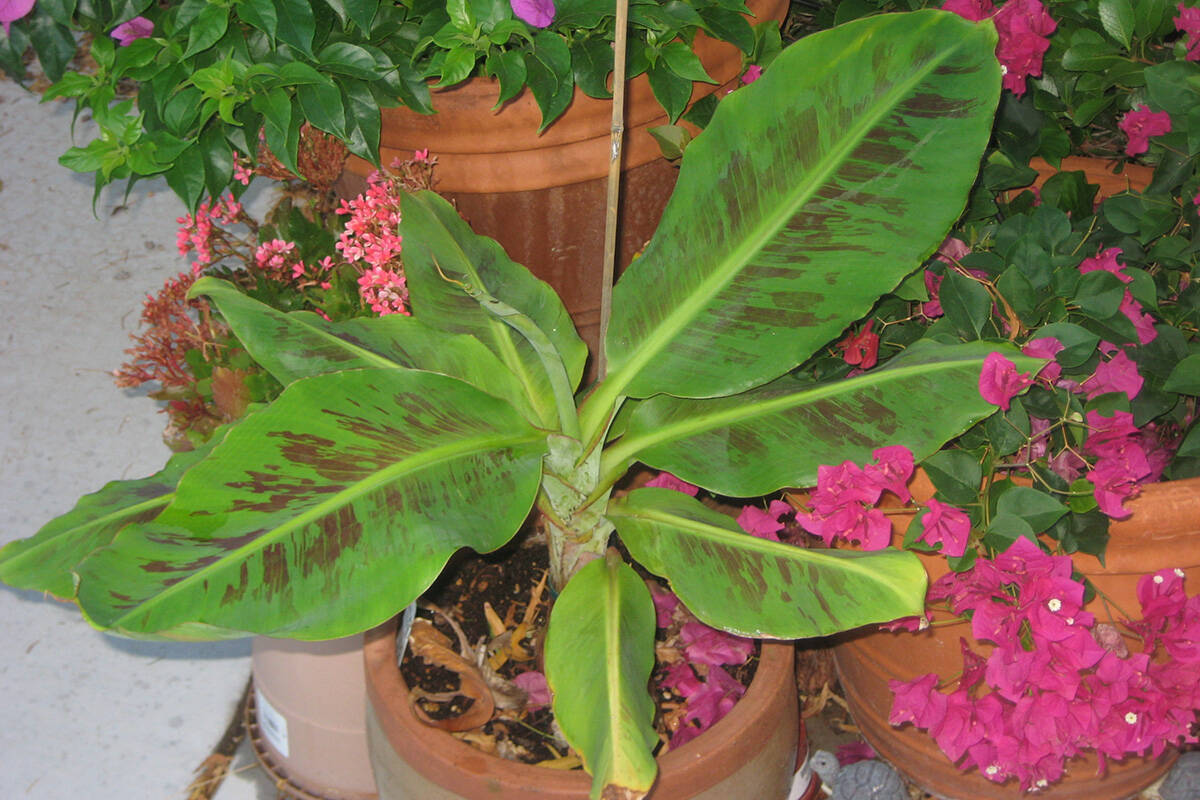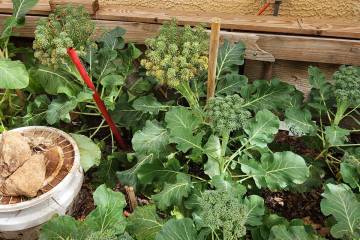When moving tree, remove some of its canopy
Q: A lemon tree was growing in my neighbor’s yard. I dug it up and transplanted it into a large pot. I am not sure what type of lemon it is. It did well for about a week, then suddenly all the leaves went limp. The plant doesn’t appear to be dying, but the leaves remain limp and hanging. What gives? I’ve never seen this before.
A: Move plants to a new location during the cooler times of the year, usually in October or February. When moving any kind of tree from one location to another, I recommend removing about one-quarter to one-third of the tree’s canopy to compensate for the loss of roots.
I also would recommend staking the plant (so the roots can’t move) until it grows new roots. Establishing it again may take a year or two of staking depending on the size of the plant. It should go without mentioning, amend the soil for a distance of about three times the size of its roots and to a depth of at least 18 inches. Keep everything wet.
Leaf loss usually occurs as the temperatures get warmer and the weather is windy. If you are successful in moving the plant, there should be no losses. It should take off when it gets warmer.
If you don’t remove enough of the top canopy, then part of the plant will die to compensate for lost roots. When not enough of the top is removed and the plant is moved or the plant does not get enough water, new growth of the tree or shrub occurs at the base of the tree and the top dies.
When moving any kind of plant, do it as quickly as possible. Have the hole pre-dug, the amendments and stakes ready.
Q: A couple of years ago I sent you pictures of my Cavendish banana. I continue to overwinter the plants in the garage, cutting the leaves back and providing a little water once a month. I put them outside when the night temperatures reach 50 degrees. I separated the mother plant from the biggest baby this spring as I moved them outside, and now another baby has developed and is bigger than the mother. No bananas yet, but the plants are pretty and fun to grow.
A: Bananas are a lot of fun to grow. Some varieties, like the Cavendish, can get 8 to 10 feet tall and 4 feet wide. Dwarf Cavendish is about the same size.
The reason Cavendish and Grand Nain (Chiquita) bananas were successfully exported is because of their longevity quality and acceptable flavor. There are other bananas that are sweeter, but their keeping quality is not as long. The smaller types, usually denoted as dwarf, are usually better for containers when moving them into a garage during freezing winters.
The usual temperature for getting chilling damage when growing in the spring is around 50 degrees. During the winter, many can handle near-freezing temperatures better, which is why many types survive the cold of garages. The low temperature of the garage negates their need for light and reduces their water use.
Just make sure when you water, water until it comes out of the bottom of the container. You don’t want salt buildup, which will happen with tap water originating from the Colorado River.
Bananas are what we consider herbaceous perennials, meaning they don’t develop any wood; they are called trees because of their size and main trunk.
They develop flowers from the newest growth when they get to a certain genetic size and height. From these flowers, fruit (called bananas and usually seedless) develop. We also call this type of seedless fruit “parthenocarpic” because of its lack of seeds.
Bananas are started from suckers taken from the mother plant. Suckers are removed when they are small and replanted in a new location or allowed to grow in the same spot when the mother plant is removed.
After the fruit has been harvested, the mother plant is cut down and composted. At our farm in the Philippines, the mother plant is harvested, chopped, mixed with molasses, and used for animal feed.
Q: I planted apple and apricot bare-root trees in February of last year. My apricot seems to have leaf roll last year. My apple leaves had some red on the upper surfaces of the leaves. I am deep-watering these trees and they both have bark mulch. The trees look healthy otherwise and were planted as specified when they were picked up. Both trees were painted with the 50/50 mix of white paint as specified.
A: Some leaf abnormalities always exist. Plants aren’t perfect. Whenever planting bare-root trees, it is always best to keep the roots wet. It only takes about 20 to 30 seconds for those very small roots, called feeder roots, to die from a lack of water. It is a mistake to let any roots, die.
Whenever there is root death of a plant, there can also be transplant shock or failure to grow at first. It just sits there. Make sure the roots are kept wet after planting. This does not mean watering every day.
Secondly, it’s OK to buy plants with branches that are too low. It is easier to remove branches than put them back. Our desert sun can be intense, particularly when it’s shining in full glory on the west and south sides of a tree.
Painting the trunk with white latex paint, mixed half and half with water so it goes further, gives you only about 5 or 6 degrees of cooling below the trunk’s surface temperature. When the sun is full bore for 10 or 15 minutes on the trunk of a fruit tree, that can be devastating with or without tree paint. It is important to keep the direct sunlight shaded on the trunk or limbs of a tree until it can provide its own shade.
Fruit trees will be much better off when they get bigger and provide their own shade.
Q: We planted six tomato plants in mid-March — a mix of Sweet 100s, Champion and another plum tomato. We have been watering, using Miracle Gro for tomatoes and watching them closely. The plants appear stunted. We have them in cages, and they have only grown a short distance up the cage. Any suggestions?
A: Planting dates for tomatoes in our climate can range from mid-February to mid-March. Watch the weather and use your weather app on your phone. It’s been cold lately. Wait for temperatures to warm up a bit.
Tomatoes are a warm-season crop, and they prefer soil and air temperatures a bit warmer than our spring provides at times. Our spring temperatures have been erratic. Low soil temperatures can slow tomato growth even if the air temperatures are high.
About a week before you are to plant tomatoes, cover the soil with clear plastic and seal the edges. This is so the warm temperatures under the plastic don’t leak out.
Warm the soil temperature to at least 65 degrees in the top few inches. I would slit the plastic and plant at that temperature. A soil thermometer stuck in the soil an inch or two deep helps you to check it.
Raised beds in full sun warm up much faster in the spring than those raised beds in the shadow of a wall or home. Have two raised beds: one for early production in the spring and another for later production.
Q: My daughter’s pine tree is dying from the top. It gets plenty of water and I don’t see any obvious insect damage. Any suggestions? Should I try a systemic poison? More or less water?
A: The usual problem is water. Other problems are insects and diseases, but they are much less common.
Watering a tree such as pine requires enough water to wet the soil to about 3 feet deep. This water should be applied to no less than half the area under its canopy. That’s a lot of water but it does not have to be done that often.
The idea is to give it enough water to last until the next irrigation. That requires the water it uses in storage in the soil. This soil water is used by the trees until the next irrigation.
Trees use water at the soil surface first, then water at lower levels progressively later. This is the reason why lawns give a tree too much water, too often, and tree roots grow shallow. Try to fix a possible water problem first before you think of other possibilities.
Bob Morris is a horticulture expert and professor emeritus of the University of Nevada, Las Vegas. Visit his blog at xtremehorticulture.blogspot.com. Send questions to Extremehort@aol.com.























